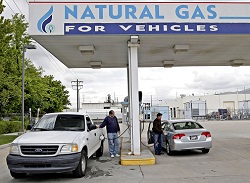Search Options Trading Mastery:
Natural Gas Options
Natural Gas Options are commodity based options with the underlying asset being a natural gas futures contract. These futures contracts are agreements between buyers and sellers, to take delivery of an agreed quantity of natural gas on an agreed delivery date. The options contracts are affected by price movements in the futures contract, which in turn, is affected by the market price of natural gas itself.
If you own a natural gas call option, you will profit if the price of natural gas futures rises. This is because a call option gives you the right but not the obligation, to take a long position in the underlying futures. If you have purchased a natural gas put option, you're hoping for a fall in natural gas futures because put options give you the right but not the obligation to take a short position in the futures. Once the options expiration date has passed, your rights to profit from either of these price movements will cease.

Where Natural Gas Options are Traded
The place to go for these options prices is the New York Mercantile Exchange (NYMEX). The NYMEX Natural Gas Options are "American style options" which are priced in US dollars and quoted against an underlying futures contract covering 10,000 btu's of natural gas. Natural gas futures are the second most popular energy product traded on the Chicago Mercantile Exchange (CME) so options for them are quite liquid.
If you're bullish on the price of natural gas, you could either buy call options, a bull call debit spread, or sell a bear call credit spread. If you're bearish on natural gas prices, you could buy put options, or a bear put debit spread, or sell bull call credit spreads. If you don't know which way the price of natural gas will go but believe that its price action will soon become volatile (natural gas is a notoriously volatile commodity), you could use straddle or strangle option strategies.
Why Options and Not Futures?
The advantage of trading natural gas options instead of their underlying futures, is that you have more opportunities for a variety of trade setups using any number of option trading strategies, some of which are mentioned above. Futures contracts don't provide this flexibility. Not only that, but with options, your potential losses are always limited to either the amount invested, or the margin required for the positions, depending on the type of strategy you're employing. Losses on adverse movements in futures contracts are potentially unlimited.
Moreover, since your options positions are based on the underlying futures contract, you gain additional leverage on price movements. Options on futures are much cheaper than the futures contracts themselves. However, you could also combine options with natural gas futures contracts. For example, you could hedge long futures positions with put options, or short futures positions with call options. Because the pricing models of these derivatives work differently, you can often use this to realize an overall profit. You could also construct a covered call type setup using both long futures and call options.
There are many interesting alternatives.
With natural gas options you should always be aware of option time decay (sometimes called theta decay). If you're an option seller, this works to your advantage, but if a buyer, your out of the money positions will erode rapidly as expiration date approaches.
To start trading natural gas options, simply open an account with any reputable broker such as ThinkorSwim by TD Ameritrade and you'll have the choice of trading futures, options, or both.
**************** ****************
Return to Commodity Options Trading Contents Page
Go to Option Trading Homepage














New! Comments
Have your say about what you just read! Leave me a comment in the box below.